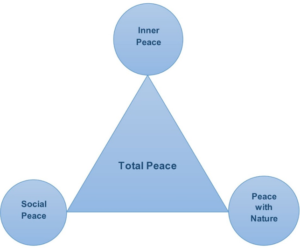
ISSN-2348-8824(Print), 3048-5061 (Online)
RNI No: HARENG/2021/35200
Vol, XIV, No. 1 August 2023 – Nov-2023
Abstract
Peace Education in the 21st Century
In order to create a world where peace is a choice over conflict, we need to imbibe the value of peace right from the beginning. Children absorb the most in the early childhood years and in this period their brain architecture shapes up with the experiences they have from the environment and the people they come in touch with. It is essential to educate the future generations about the competencies, perspectives, attitudes, values, and behavioural patterns that will enable them to build and maintain peace in the 21st century.
Introduction
What is peace?
Peace is a state of calmness and an absence of violence or conflict. Peace of mind denotes a state of existence that is free of anxiety, fear, unrest, chaos, or conflict. A mind that is peaceful is always conducive to thinking in the right manner, taking the right decisions, and working at an optimum level. A peaceful mind is also a creative mind that can explore endless possibilities.
If we want to understand the essence of peace, we need to look into the sources of peace.
There are three sources of peace:
- Inner Peace
- Social Peace
- Peace with Nature

Image 1: Sources of peace (Balasooriya 2001)
- Inner peace or peace of mind is a state of harmony and peace with oneself. It is associated with loving oneself and having a positive self-esteem. One can attain inner peace by being caring, compassionate, forgiving, happy and contented.
Social peace is “learning to live together” in harmony with other human beings. For example, peace between humans through negotiation and conflict resolution, unity, and friendship. Social peace enables an individual to exist in a peaceful state.
Peace with nature implies having a feeling of oneness with nature and not indulging in any activity that disrupts the balance between man and nature.
Therefore, to imbibe a culture of peace all three sources of peace need to be worked upon.
Peace Education in Early Years
Mahatma Gandhi once stated, “If we are to reach real peace in this world, we shall have to begin with the children.”
To be peaceful human beings, children need to practice the culture of peace right from the early childhood years.
During the early years, a child’s brain architecture develops rapidly, habits are formed, differences are recognized, and emotional ties are built through social relationships and day-to-day interactions at home and in the neighbourhood.
As Stacy M. Alfonso in her article, ‘Peace Education in Early Childhood Education’ stated, “Early childhood is a time when a child is laying the foundation for future development capabilities across all domains.” The interplay of language, cognition, physical abilities as well as socio-emotional capacities come into use more frequently and purposefully.
As children develop language, they use it to convey their needs and wants to express their emotions, and to solve conflicts. As children’s cognitive ability allows them to see a distinction between themselves and others, they use their new social skills to test out their friendship-making capabilities. Because of these important steps in development, early childhood becomes a crucial time for developing the skills and capacities necessary for peace-making, peacekeeping, and peacebuilding.
Emotional regulations, critical thinking, and self-control, collaboration and positive self-esteem are the core social skills of peacebuilding that develop in early childhood.
Inculcating Peace Culture in the Early Childhood Settings
Classroom Climate and Settings:
Some of the guiding principles in creating a peaceful classroom climate are as follows:
- Truthfulness
- Respect
- Cooperation
- Dignity
- Equality
- Liberty
- Justice
- Security
- Ability to Express Oneself
Settings: A peace corner may be set up within the school premises where children turn to when they feel restless or scared. This corner should consist of things such as toys, a low seating arrangement with soft cushions, books that promote peaceful behaviour, and things from nature such as pebbles, twigs, shells, stones, and leaves.
The corner may have a peace table where the children can express their state of mind through art and craft and express their feelings. Here the facilitator may converse with the children and help them understand their emotions thereby enabling them to imbibe self-control in themselves. A social-emotional corner with soft toys may be placed for the children to share their feelings with their toy friends.
They may be introduced to worry dolls or worry monsters who eat up their worries and make them happy. These nurturing elements help a child calm down when in an anxious, angry, fearful, or when in a disturbed state of mind.
The wall of the classroom should be painted with soothing colours. Dark colours need to be avoided as they may create a sense of unrest and chaos in children.
Library: A small reading rack or shelf with books can be installed in the peace corner or any other area in the centre. The books selected for the peace corner should foster positive self-esteem, values and ethics, good behavioural traits, love for plants and animals, personal awareness and positivity. These books should be colourful and have lots of pictorial representations that attract children and arouse curiosity in them.
Child-friendly furniture: Low seater tables and chairs, mats, mattresses, and shelves that are within the reach of children with adequate teaching aids should be installed. The furniture needs to have rounded edges. It should be sturdy, and it must be placed in such a manner that children do not bump into it. The classroom should be a mix of floor seating arrangements, tables and chairs, accompanied by beds for children to take rest and relax.
Facilitator Mindset: For children to understand the concept of peace, the facilitators need to create an atmosphere and a classroom climate that promotes peace. First of all, they need to model peaceful behaviour, speak the language of peace, declare the classroom a ‘peace zone’, keep the environment free of any kind of bias or discrimination, and create a learning environment that fosters peace.
Peace educators should reflect on their own potential biases and reflect on the practices that cultivate inequalities in the classroom. It is vital for them to focus on the exchange of knowledge between student and teacher, as a tool for collaboration and connection.
Practising self-care can be in the best interest of everyone in the classroom. Self-care is all about taking care of one’s health, both mental and physical, and making sure that each individual has everything he or she needs to thrive and arrest burnout.
Practices: Facilitators need to be extremely mindful of their own behaviour while dealing with the children. Mindfulness practices may be introduced in small capsules for the children so that they acquire the ability to regulate their emotions. Slow eating, slow breathing, and observing nature are simple ways in which children can learn to start living in the moment. Many activities and exercises related to mindfulness may be introduced for children so that the practice becomes a way of life for them.
Children should be encouraged to feel and label their emotions so that they are able to deal with them and regulate them. The facilitators may help children understand their emotions by talking to them about their feelings and by showing empathy towards them.
Another very important aspect of peace is gratitude. A child should feel grateful for everything and learn to appreciate the little joys of life. Facilitators should introduce them to the core skills such as empathy, compassion and gratefulness so that they grow up to be aware, responsive, and compassionate individuals.
Outdoor Settings
A congenial school should promote a green environment where children get ample opportunities to interact and learn from nature. Emphasis should be laid on nurturing conscious individuals who are aware of their responsibility to conserve nature. The school should promote green areas where plants are kept and nurtured. A variety of trees and shrubs should be there on the premises.
A flower and vegetable garden or plantation area should be available so that children can grow vegetables and flowers and learn to take care of them by watering and tending to them. Children may be encouraged to keep their own plants at home and nurture them so that the habit of taking care of nature is extended beyond the school boundary.
Pets may be a part of the school so that children are able to love and take care of them and develop a sense of responsibility towards fellow – creatures. Children should be encouraged to love animals and not harm them in any manner. They should be encouraged to rescue abandoned pets or inform their elders if they see such animals.
Bird feeders and small planters may be installed on the school premises. These may be made using waste material such as plastic bottles. This would enable children to understand the importance of waste management. They would learn to reduce, reuse, and recycle. Similarly, many other such materials may be used to make eco-friendly dustbins and paper bags.
The play area should have child-friendly equipment. During outdoor sessions, children naturally learn negotiation skills. They imbibe essential values and ethics such as peer skills, empathy, anger management and self-discipline in themselves. They also learn to deal with their feelings.
Peace education be a parshouldt of every early childhood learning environment, if we envision building a peaceful world.
Conclusion
This article focuses on the importance of inculcating a culture of peace from early years for building a peaceful world. A mind that is peaceful is always conducive to thinking in the right manner, making the right decisions, and working at an optimum level.
To understand the essence of peace, it is important to work upon the three sources of peace: Inner Peace, Social Peace, and Peace with Nature. A peace corner should be set up within the school premises to help children remain calm and composed in difficult or challenging situations.
References
- https://www.wonderschool.com/p/child-care-provider-resources/home-preschool-setup-ideas/
- https://vietnam.vvob.org/en/news/innovate-teachers-mindset-key-improving-quality-early-childhood-education-mountainous
- https://kidshealth.org/en/kids/mindful-exercises.html
- https://www.littlefloweryoga.com/blog/the-peace-corner-an-essential-classroom-resource/
- https://declutterthemind.com/blog/inner-peace/
- https://positivepsychology.com/mindfulness-exercises-techniques-activities/
- https://competendo.net/en/The_Facilitation_Mindset
- https://www.innerpeacefellowship.org/how-to-meditate/?gclid=Cj0KCQiAkMGcBhCSARIsAIW6d0Bz8dTpVfAHLz35tNl9lUmtw6GRjOQp46V7sAt98UjO2bk4IsIwuR4aAkmyEALw_wcB
About the Author
Dr. Vasavvi Acharjya is an early childhood educationist working dedicatedly in the domain of Early Childhood Education for the last 24 years. She is the Founder and Managing Director of Inner i Foundation Pvt. Ltd. and Tender Petals Pre-school Chain.
She is also the Founder and Chairperson of Debendra Nath Acharya Foundation for Children and ‘Women Welfare’ (NGO founded in 2014) and heads its Global Initiative Early Childhood Development Forum (launched in 2019). She is a recipient of multiple awards. She has been a speaker and a resource person at many national and international platforms. She is a mentor and trainer.
Reach her at: vasavi2005@yahoo.com , vasavvviacharjya@gmail.com








